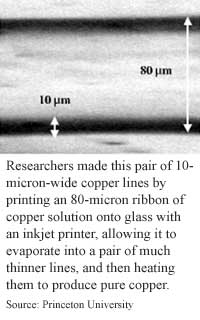
Coffee effect could benefit circuit connections
By Kimberly Patch, Technology Research NewsPrinceton researchers have coaxed a copper solution to dry into parallel stripes, making it possible to draw copper lines that are finer than the inkjet spray used to produce them.
The method is a potentially cheaper way to connect circuit board components than today's masking methods.
Researchers used glass capillaries or an inkjet printer to make lines with a solution of copper hexanoate and alcohol. As the alcohol evaporated, the copper sediment separated into one or two pairs of strips. The researchers then annealed, or heated, the strips to turn them into pure copper lines.
Using this method, they produced a pair of 10-micron-wide lines from an original ribbon of 80-micron-wide solution printed onto a glass slide with an ordinary Epson inkjet printer.
The force that caused the solution to dry into parallel lines is in evidence in something as ordinary as a coffee stain, said Sandra Troian, associate professor of chemical engineering and physics at Princeton University.
While a solution evaporates, it cools, and the cooling causes a flow of parallel, rotating cylinders within the line of liquid. Because of this flow, particles in the solution are deposited at the edges of the original line of liquid, said Troian. "So as the liquid's evaporating it ends up plating out these long ribbons," she said. In a dot of liquid, the effect causes bulls-eye-like rings.
The researchers have tuned the effect to get the copper lines to form T or L shapes, and have produced lines of four stripes. The researchers are now trying to produce thinner lines. "We're hoping we can go down to one micron," said Troian.
The thickness and number of copper lines depend on the size and viscosity of the original liquid line, probably because the size of the rotating cylinders of liquid are determined by the height of the line, said Troian. "Therefore the smaller the thickness, the smaller the roll and [the] narrower you can make your lines -- we're pretty sure of that," she said.
The researchers are also working to make a larger number of parallel lines. "For [a certain] volume of material, if I print a line of such and such a size and I know the difference in temperature between the substrate and cool surface, I should be able to predict ... the number of lines. We want to quantify that," said Troian.
Another step is testing the copper to make sure the annealing process they use produces copper suitable for carrying electrical current, Troian said. That testing should be finished within a few months, she said. The researchers are also working on a formula that would allow them to print aluminum lines.
The printed copper lines could be used as a cheap replacement for masking methods to produce interconnects on circuit boards within one or two years said Troian. In addition, because the process doesn't require a rigid substrate, it could also work in future technologies that require copper lines on substances like plastic and cloth, Troian said.
Troian's research colleagues were Tanja Cuk, Cheong Min Hong and Sigurd Wagner, all of Princeton. They published the results in the September 25, 2000 issue of Applied Physics Letters. The work was funded by the Defense Advanced Research Projects Agency (DARPA) and the National Science Foundation (NSF).
Timeline: 1-2 years
Funding: Government
TRN Categories: Semiconductors and Materials
Story Type: News
Related Elements: Technical paper "Using Convective Flow Splitting for the Direct Printing of Fine Copper Lines," Applied Physics Letters, September 25, 2000
Advertisements:
November 8, 2000
Page One
Electronics link mind and body
Chip promises faster light-to-circuit link
Coffee effect could benefit circuit connections
Tiny silicon crystals loom large
Switch offers cheap local-long distance link

News:
Research News Roundup
Research Watch blog
Features:
View from the High Ground Q&A
How It Works
RSS Feeds:
News
Ad links:
Buy an ad link
| Advertisements:
|
 |
Ad links: Clear History
Buy an ad link
|
TRN
Newswire and Headline Feeds for Web sites
|
© Copyright Technology Research News, LLC 2000-2006. All rights reserved.